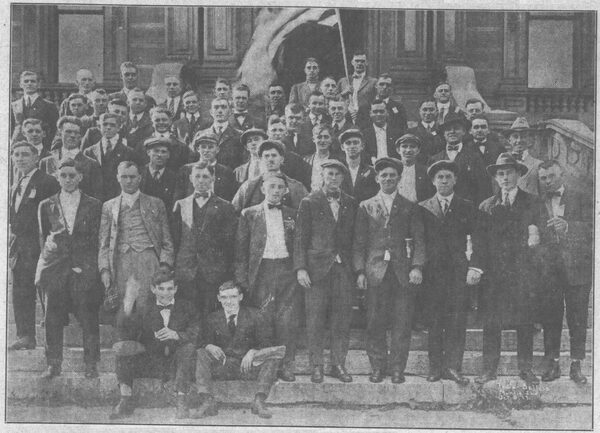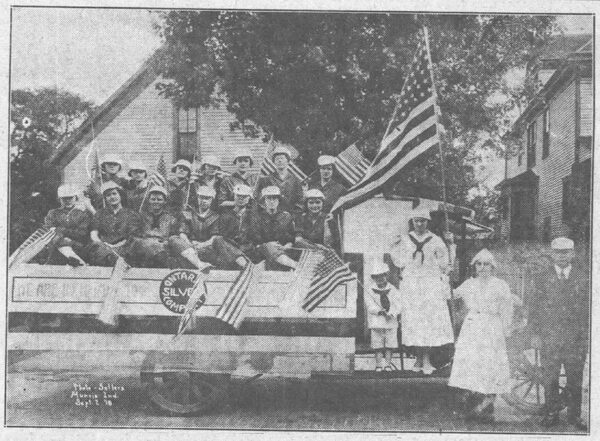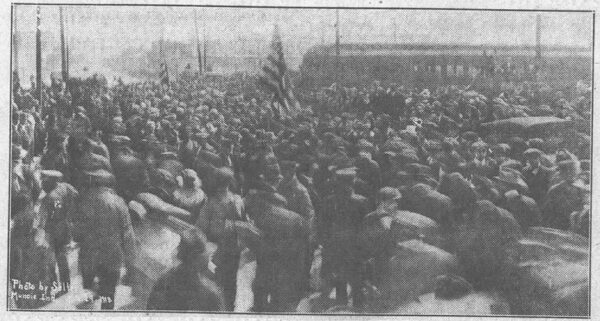[Newspaper]
Publication: The Muncie Evening Press
Muncie, IN, United States
vol. 43, no. 215, p. 3*, col. 1-8
GO BACK WITH THE PRESS TO THOSE GRIM DAYS OF 1914 TO 1918
County Sent 2,600 Youths to
Colors; Raised 11 Million
Dollars for War Purposes
"Heatless and Lightless" Days Enforced to
Save Fuel — Firemen Spent Idle Time
Making "Trench Candles" From Paper
and Paraffin
LOCAL PLANTS MAKE WAR MATERIALS
BY DALE W. BURGESS.
June 27, 1914, Delaware County farmers were threshing a bumper wheat crop and there was talk of replacing the stone walks around the courthouse with concrete. Single G, a sensational 4-year-old colt owned by W. G. Barefoot and Company, of Cowan, had won a $1,000 purse at Monroe, Mich., a few days before and The Press carried an account of the race.
There was strong local interest in the heavyweight boxing championship fight between Jack Johnson, the colored giant, and Frank Moran, of Paris. Johnson got the decision after 20 rounds of unexciting pushing and pulling. Georges Carpentier was the referee.
Mayor Rollin H. Bunch issued a proclamation to the effect that fireworks were prohibited in Muncie on the approaching Fourth of July.
Archduke Francis Ferdinand, heir to the Austrian throne, was pistoled that day at Sarajevo, Bosnia.
There was a rush of events leading to the United States' declaration of war, April 6, 1917. It was Good Friday. The ultimate cost to the nation was more than 112,000 killed in battle and by disease, 236,000 wounded and considerably more than $30,000.000.000.
53 From County Killed.
Fifty-three Gold Stars showed on the service flag of Delaware County when the World War ended. Some of her sons died at Chateau Thierry, Argonne Forest and in other battles that turned the tide on the Western Front. Scores of others from the county’s contribution of 2,600 men returned sick and wounded.
Muncie’s warm welcome to the American Legion will demonstrate that the Gold Star flags have not been furled. The roll of honor has not been forgotten.
There is another list of patriots engraved on no memorial shaft — the civilian warriors who labored at home to supply the needs of the army. Defaulting debtor nations of Europe, new understanding of events leading up to the conflict and growing doubt as to the wisdom of our participation cannot destroy their pride in knowing they did their part in a national emergency.
11 Millions to War Fund.
Delaware County raised more than $11,500,000 or almost $200 for every person in the county, for war purposes. In various campaigns for war funds, the county raised an average of 200 per cent of her quota.
Those were the days when the slogan was "work or fight," and housewives broke mop handles over the heads of the few tramps that came to their doors.
The official "line of communication" between the people of the county and the federal administration was the Delaware County Council of Defense. There was a state council of defense, appointed by the Governor, and county defense council members were named by circuit court judges.
As Delaware County Doughboys Began "Long Trail"
|
On the day this picture was taken, October 5, 1917, Art Redding became weary of waiting for the troop train and made the immortal remark, "This is the first war I was ever in that was late in getting started!" Sixty-five Delaware County recruits are pictured on the east steps of the courthouse, shortly before they left for Camp Taylor. Note the button shoes, short pants and high collars. Although all the men in the 19-year-old photograph have not been identified, it is believed, only the Center Township recruits are shown. They include William Brown, Harry Robbins, Leo D. Snider, Max L. Jeffrey, James W. Shirey, Earl O. Thornburg, Herman Polson. Arthur Redding, Gong Dung Jung, Gaylord Dittemore, Roy E. Miller, Paul W. McVicker, John Lennington, Goldie Butler, James C. Vinson, Ellis Baldwin, Ray Lee Jones, Paul E. Norris, Burne A. Cheesman, Russell Steed, Byron Neff, Carl A. Ramsey, Earl D. Hoechst, William Holman, Charles F. Joslin, Jr., Rod J. Wesley, Elmer E. Gentry, Courtland Asher, Holman F. Burton, Arthur W. Farling, Albert D. Spaulding, Curney Supinger, Robert R. Armour, Zyrnie Eley, Floyd Baker, William S. Sargent, Alonzo E. Blake, Clyde Scott, Milton A. Williams, Abner Brown, Earl E. Cook, Otis Burgess, Homer Stethen, Earl Vasbinder and Lawrence Duffy. Delaware County boys from outside Center Township who left for Camp Taylor that day include Ralph Waller, Charles M. Moorehead, Irvin Heath, William G. Ogle, Floyd Janney, Glenn Dolph Snider, Ray C. Chapman, March Sayford, John F. Nickey, Loren B. Markle, Guinn A. Berry, Lawrence Arment, Ira L. Myers, Clarence White, Carl M. Mitchell and Murray D. Peterson.
Judge W. A. Thompson of Muncie appointed the late George B. Lockwood, publisher of The Press, as chairman of the Delaware County group. It later was necessary for Mr. Lockwood to leave the city and he was succeeded by Will F. White, Muncie attorney. Other members were Mrs. Gladys W. Rose, Howard A. Brown, Samuel D. Morris of Eaton, Lee N. Way of Albany and Michael T. Hanley. Miss Genevieve H. Hanna later succeeded Mrs. Rose. Harry Kitselman was appointed to fill the vacancy created by Mr. Lockwood’s departure but he entered the federal ordinance service and J. Lloyd Kimbrough was appointed.
Wartime activities became so broad in scope that the defense council divided the county into three parts, with assistant chairmen in charge of each. Clarence Retherford was leader of the east tier of townships, Jesse White of the center tier, and Harrold Hobbs of the west tier.
Remember the ‘Slacker?’
The defense council brought about enactment of city ordinances in Muncie for punishment of "war prevaricators" and the adequate handling of the loafer and slacker, organized a speakers' bureau under the direction of Arthur D. McKinley, assisted in solving labor problems, helped to obtain physicians and nurses for war service. organized the schools in an Americanism campaign and supervised the conscription organization for operation of the selective enlistment law.
Women of the county organized the Women’s County Council of Defense, and Miss Genevieve H. Hanna as chairman. Mrs Harry E. Snyder was vice-chairman. Other members of the central committee were Mrs. C. G. Williams, secretary; Mrs. J. Carl O’Harra, treasurer; Mrs. A. T. Applegate, Mrs. M. T. Hanley and Mrs. E. W. Barrett.
The women’s organization promoted registration of women, food production and home economics, food administration, child welfare, maintenance of social service agencies, health and recreation, education, Liberty Bond sales and public addresses by "Fourteen Women" and "Four Minute Women."
There also were "Four Minute Men," speakers organized and directed by the Muncie Advertising Club under the leadership of D. O. Skillen.
No Crop Scarcity Then.
Delaware County farmers, faced with demands for increased production of beef, pork and grain, complied despite the fact that, there was a shortage of 30 per cent in farm labor and there were unseasonable frosts. They had planted 14,000 acres of wheat in 1916 but winter freezing killed all but 1,000 acres. The acreage was increased to 16,000 in 1917 and 24,000 in 1918. The farmers lost half their 70,000-acre corn crop in 1917 due to its failure to mature, A June frost in 1918 killed more than 60 per cent of the corn — a loss of fully $3,000,000.
Although the tremendous losses of corn reduced hog feed, the county’s pork production was increased 10 per cent in 1918. Rye became a substitute for wheat and corn. While increasing their corn and wheat acreage, the farmer maintained normal acreage of oats, barley and rye.
School Gardens Helped.
War gardens had a prominent place in the Delaware County program. There were 7,050 war gardens in 1918, producing products which took the place of such foods as wheat, pork and beef, which were being shipped abroad Each school had a garden. There was canning instruction at Central High School and township trustees provided canning outfits. With the township equipment, 57,000 quarts of fruits and vegetables were canned. In the fall of 1917, the township canners were turned over to the domestic science departments of schools.
David T. Haines was food administrator in Delaware County, with Robe Carl White as assistant. Use of sugar and flour was controlled and requirements for use of flour substitutes were enforced.
F. D. Haimbaugh, Muncie postmaster, headed the Delaware County Fuel Administration, which sought to save fuel through "lightless nights" and heatless days." In the unusually cold winter of 1917-18 its problem became the dsitribution [sic] distribution of fuel, rather than the saving of it. In January, 1918, when Muncie was blockaded by snow for several days, the administrator seized several carloads of coal in transit, after learning it was impossible for the railroads to move the cars to their destination.
Most of the county’s stores were placed on a "cash and carry" basis by the Merchants’ Economy Committee. headed by J. C. O’Harra, who also acted as state chairman after F. M. Ayres, of Indianapolis, left the state chairmanship for Red Cross work in Washington. Use of electric signs was curtailed and display windows were left unlighted at night. Stores opened later and closed earlier to save electricity and fuel.
War Materials Manufactured.
Many months before the United States entered the war, several Muncie industries were making war supplies for the British and French governments. During 1918, about 90 per cent of the production of local factories was in some form of war supplies. Three factories made gears and transmissions for automotive war equipment. Another factory made artillery wheels. The Hemingray Glass Company made large quantities of glass insulators for telephone service in the war zone.
They Helped Keep "Home Fires Burning"
|
Delaware County women took over men’s tasks when the ranks'of labor were depleted during the World War. Above is shown a float of the Ontario Silver Company in the great “Win-the-War” demonstration and parade. Labor Day, September 2, 1918. “We are in khaki, too," is the legend on the side of the truck. Other floats showed war materials manufactured by Muncie industries, some of which had been making munitions for the Allies before America declared war.
The Ontario Silver Company made mess table equipment and the Moore Manufacturing Company made army beds. The Durham Manufacturing Company made fireless cookers for hospitals and army camps. Castings for hundreds of Liberty motors came from a Muncie foundry. The Gill Clay Pot Company made clay crucibles used by manufacturers of periscope and field glass lenses. Plants of the Indiana Steel and Wire Company and of Kitselman Brothers wove thousands of tons of heavy barbed wire for the western battle front, poultry netting for use in camouflage of roads and trenches and miles of telephone and telegraph wire. The wire mills were preparing to make heavy wire screen, to be used to support trench walls in place of wooden braces, when the war ended
Ship Beams Made Here.
The Indiana Bridge Company plant became an "inland shipyard." Floor beams for the "Agawan," first ship of fabricated steel ever built, came from the local yard. The ship was assembled at Newark Bay, N. J.
Millions of fruit jars used in the nation’s food conservation campaign came from the Ball Brothers Glass Company.
Several Delaware County men entered the ordnance department as civilian experts. The number included O. B. Bannister, Muncie, wheel manufacturer who was a wood-stock expert; Frederick D. Rose, who held the rank of first lieutenant in the office of the chief of ordnance, artillery assembly, at Washington! Harry L. Kitselman, John Fitzgibbons and Chauncey Hanika.
Muncie firemen made thousands of trench candles, made of strips of newspaper boiled in parafine. Each candle burned two hours without drip of flare and gave a light equal to about four ordinary candles. They first were made by hand, but a machine was developed to turn out 800 to 1,000 candles a day. Sweaters for the Red Cross also were knit by the firemen.
Muncie and Delaware County did not have a Red Cross chapter when the United States declared war, although a few months before they had contributed $5,000 for tornado sufferers at Newcastle and funds for storm victims at New Albany. The D. A. R. and the French Relief Association had been aiding war victims.
Red Cross Unit Formed.
The Muncie Red Cross chapter was organized April 25, 1917 with the following charter members: The Reverend Edward G. Mason, Frank J. Claypool, A. E. Boyce, C. H. Mitchell, C. L. Galliher, Dr. O. L. Boor, Dr. George R. Green, George A. Ball, Karl A. Oesterle, W. T. Haymond and T. F. Rose.
In a three-day drive for funds, beginning June 5, 1917, the Red Cross collected $40,097 in cash and pledges. St. Martha's Guild offered the use of part of its room in the Boyce Building, and it was turned into a Red Cross workshop. The French Relief movement became a part of the Red Cross in October and a larger workship [sic] workshop was opened on the fifth floor of the Johnson Building. Another financial drive, in May, produced $88,289.
Under Red Cross leadership, women of the county made 173,177 surgical dressings, 7,691 housewife kits, 14,152 knitted articles, 1,223 articles of hospital supplies, 179 garments for refugees and 6,244 hospital garments in the workshop. Thousands of other articles were made by auxiliaries in the county outside of Muncie. it is recorded that Mrs. Sarah C. Bradbury of Muncie knit 155 pairs of yarn socks for soldiers.
During the influenza epidemic in 1918 and 1919 the Red Cross assisted in supplying equipment for patients in the Indiana State Normal School, now Ball State Teachers college, and the Emergency Hospital.
*Food Served Soldiers.*
A Muncie unit of the Red Cross Canteen Service was organized to serve food to soldiers and sailors who passed through Muncie on troop trains. During July and August, 1918, the Muncie Canteen served about 10,000 soldiers.
Thousands of Delaware County school children applied their needles to the making of supplies for the Junior Red Cross. The youngsters shipped boxes of supplies to France and Belgium, made checker games for Y. M. C. A. huts and dipped trench candles.
No organization worked more tirelessly than the War Mothers Society, formed in February, 1918. The mothers joined in Red Cross work, sent Christmas boxes to the boys in France, read their letters aloud to one another and sent a flower committee to the homes of those whose sons were not to return.
Crowd Cheers Muncie Recruits Off to War
|
In this picture the camera caught a part of the crowd that gathered at Union Station, March 29, 1918, when 45 Delaware County recruits left for Camp Taylor in an L. E. and W. troop train, but it failed to show the grief of parents. wives and children. So disorganized was the group of soldiers to-be that the late Charles Bowden, chairman of Conscription Board No. 1. was forced to accompany the men as far as New castle to complete the roll call.
In four Liberty Bond campaigns, Delaware County purchased $8,676,800 worth of the wartime securities. The first bonds taken in the county were placed through the banks and were purchased by relatively few persons and corporations, most of the purchases being by persons familiar with investment securities. In the later campaigns, bonds were sold to thousands of persons through the most elaborate financial organization in the history of the county. In addition to the bonds, the county met a War Savings Stamps quota of $1,054,360. Thrift was obligatory
Muncie had its Home Guards — Company L, Third Regiment, Third Battalion of Infantry, Indiana State Militia. It was organized late in 1917 at the suggestion of the County Council of Defense, by Parrish Martin Camp No. 21, United Spanish War Veterans. It had a total enlistment of 146 officers and men, of whom 46 went into the regular army, and had 82 officers and men at the close of the war. The Home Guards provided pall-bearers and firing squads for military funerals of soldiers brought home for burial, assisted police at public demonstrations and participated in all of the Red Cross and War Savings Stamps movements. It also supported a French orphan.
County Equal to Task.
The Indiana State Normal School had a unit of the Students’ Army Training Corps, with a maximum enlistment of 125. The quota was filled soon after the movement was organized in the fall of 1918. First Lieutenant Joseph L. Morrison of the United States Army was commandant.
An account of wartime activities in Delaware County could be expanded into a large book. Everyone old enough to remember the war has recollections of the "Block Workers," the conscription boards, public farewells to soldiers, the Merchants’ War Chest, the Y. M. C. A. activities, food cards, the Americanization Committee, the Patriotic League, the Knights of Columbus War Fund, the United War Work Campaign, the Rotary Club’s Smileage Books and the county’s volunteer nurses.
Some of the county’s residents made money from the war, but anyone who was in Muncie on November 7, 1918, could have had no doubt that the two years were a trying period for the mass of the population. That was the day it was mistakenly announced that the armistice had been signed. From stores, factories and homes, thousands of shouting and singing people poured into the streets. Whistles, bells and every known noise-making device created thet [sic] the loudest din ever heard in Muncie up to that time When the true armistice was announced, November 11, the celebration was renewed with undiminished vigor. Only physical exhaustion ended the demonstration.
Delaware County had proved it could meet all wartime demands, but it didn’t care to be tested a second time.


